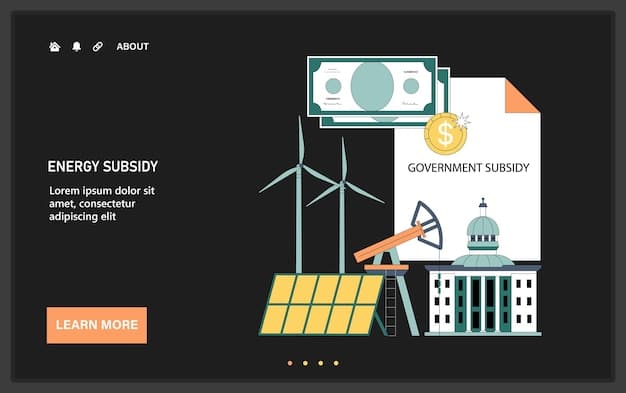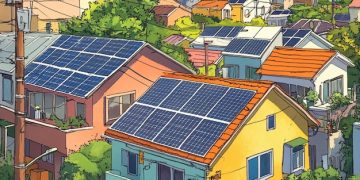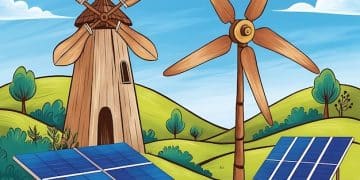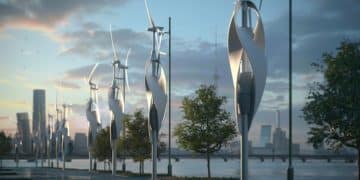US Climate Goals & Renewable Energy Investment by 2025

The updated US climate goals are set to significantly accelerate renewable energy investments by 2025, driven by policy incentives, regulatory frameworks, and increasing investor confidence, aiming for substantial decarbonization and economic growth in the clean energy sector.
The landscape of global energy is undergoing a transformative shift, with climate change emerging as a central driver of policy and economic decisions. In the United States, this transformation is particularly pronounced, given its economic power and historical emissions. A pressing question for investors, policymakers, and environmentalists alike is: How will the updated US climate goals impact renewable energy investments by 2025? This isn’t merely an academic query; it delves into the tangible effects of ambitious environmental targets on capital allocation, technological development, and market dynamics within the burgeoning renewable energy sector.
Understanding the Foundation: The Current US Climate Policy Landscape
The United States has recently recommitted to an aggressive climate agenda, signaling a clear departure from previous policies. This renewed focus is underpinned by a scientific consensus on the urgency of climate action and a recognition of the economic opportunities inherent in the transition to clean energy. This commitment manifests in various forms, from executive orders to legislative proposals, all designed to steer the nation towards a sustainable future.
The current administration has outlined ambitious targets, including significant reductions in greenhouse gas emissions by 2030 and a pathway to net-zero emissions by 2050. These goals are not just abstract numbers; they serve as critical guideposts for policy development, regulatory frameworks, and strategic planning across industries. For the renewable energy sector, these targets represent a clear demand signal, indicating a robust and sustained need for clean power solutions.
Key Legislative and Executive Drivers
Several pieces of legislation and executive actions are shaping this new climate trajectory. The Inflation Reduction Act (IRA) stands out as a monumental piece of legislation, offering unprecedented incentives for clean energy deployment and manufacturing. It includes tax credits, grants, and loan programs designed to reduce costs, encourage innovation, and accelerate the adoption of renewable technologies.
- Investment Tax Credits (ITCs) and Production Tax Credits (PTCs): Extended and expanded, these credits significantly improve the financial viability of solar, wind, and other renewable energy projects.
- Domestic Manufacturing Incentives: Provisions encouraging the domestic production of renewable energy components aim to strengthen the US supply chain and create green jobs.
- R&D Funding: Increased funding for research and development seeks to foster breakthroughs in energy storage, advanced renewables, and carbon capture technologies.
Beyond the IRA, executive orders have directed federal agencies to prioritize climate considerations in their operations, procurement, and regulatory decisions. This whole-of-government approach ensures that climate objectives are integrated across various sectors, from transportation to agriculture, creating a stronger institutional push towards decarbonization. The momentum generated by these policy measures creates a fertile ground for sustained growth in renewable energy investments, providing long-term predictability that investors crave. This stable policy environment, in turn, helps de-risk projects, making them more attractive for capital deployment.
Anticipated Shifts in Renewable Energy Investment Trends
The updated US climate goals are poised to be a powerful catalyst, fundamentally altering the trajectory of renewable energy investments. Projections indicate a significant surge in capital flowing into the sector as investors respond to improved economics, supportive policies, and growing market demand. This influx of capital is expected to manifest in various ways, from increased project development to expanded manufacturing capacity.
The economic viability of renewable energy projects has dramatically improved, bolstered by declining technology costs and strong policy incentives. Solar and wind power, in particular, are now often the cheapest forms of new electricity generation in many regions, even before factoring in subsidies. The long-term extensions of tax credits under the IRA further enhance these economics, providing certainty that was previously lacking.
Focus on Specific Renewable Technologies
While all renewable energy sectors stand to benefit, some are likely to see more pronounced growth. Solar and wind energy will continue to dominate, given their mature technologies, scalability, and cost-competitiveness. However, other technologies are also positioned for significant expansion.
- Solar PV and Wind Power: Expect continued rapid deployment, with a strong emphasis on utility-scale projects and distributed generation. Innovations in panel efficiency and turbine design will further drive down costs.
- Energy Storage: The intermittent nature of solar and wind necessitate robust energy storage solutions. Battery storage, particularly lithium-ion, will see massive investments, driven by both grid-scale applications and behind-the-meter installations.
- Green Hydrogen: Policies supporting the production of green hydrogen, derived from renewable electricity through electrolysis, will spur investments in this nascent but promising sector, particularly for decarbonizing heavy industries and long-haul transportation.
- Geothermal and Hydropower: While more geographically constrained, investments in advanced geothermal systems and modernization of existing hydropower infrastructure will also grow, contributing to a diversified clean energy portfolio.
The shift is not just about increasing gigawatts; it’s also about building out the entire ecosystem. This includes investments in grid modernization, transmission infrastructure, smart grid technologies, and digital solutions that optimize energy production and consumption. The need for a resilient and interconnected grid capable of handling a high penetration of renewables will drive substantial capital into these enabling technologies. Investors are increasingly looking beyond individual projects to the broader infrastructure that supports the clean energy transition.
Impact on Capital Flows and Financial Mechanisms
The financial landscape for renewable energy investments is evolving rapidly, with updated US climate goals playing a pivotal role in shaping capital flows and the mechanisms used to finance projects. A key trend is the increasing involvement of institutional investors, who are now viewing clean energy as a stable, attractive asset class. Pension funds, sovereign wealth funds, and insurance companies are allocating significant capital to renewable energy, drawn by predictable cash flows, long-term contracts, and increasingly diversified portfolios.
The policy certainty provided by legislation like the IRA reduces perceived risks, making renewable projects more appealing to a broader range of investors. This is leading to a more competitive financing environment, potentially lowering the cost of capital for developers. The “green finance” movement is also gaining traction, with a proliferation of green bonds, sustainability-linked loans, and ESG (Environmental, Social, and Governance) investment funds. These financial instruments allow investors to directly support climate-positive projects while meeting their own sustainability mandates.

The Role of Public and Private Partnerships
The scale of investment required to meet the updated climate goals necessitates a collaborative approach, with public and private capital working in tandem. Government programs, such as loan guarantees and grant funding, de-risk early-stage technologies and infrastructure projects, attracting private investment that might otherwise be hesitant.
- Federal Loan Programs: The Department of Energy’s Loan Programs Office plays a crucial role in supporting innovative, large-scale clean energy projects that might struggle to find conventional financing.
- State-Level Incentives: Many states are complementing federal efforts with their own renewable portfolio standards, tax incentives, and grant programs, further stimulating local investment.
- Corporate Power Purchase Agreements (PPAs): Corporations are increasingly signing long-term PPAs directly with renewable energy developers, locking in clean electricity prices and providing a stable revenue stream for projects, which in turn attracts financing.
This blended finance approach leverages public funds to catalyze private investment, creating a multiplier effect. It also allows for the deployment of capital into areas that might be underserved by purely private markets, such as rural communities or emerging technologies. The synergy between public policy and private capital is essential for achieving the ambitious scale of renewable energy deployment envisioned by the updated climate goals. This collaboration not only accelerates the energy transition but also distributes its economic benefits more broadly across the country.
Regulatory Frameworks and Grid Modernization
Meeting the updated US climate goals goes beyond simply deploying more solar panels and wind turbines; it requires a robust and adaptable regulatory framework and significant investments in grid modernization. The sheer volume of intermittent renewable energy coming online demands a smarter, more resilient grid capable of handling fluctuating power flows and integrating diverse energy sources. Regulatory bodies at both federal and state levels are grappling with the challenges of permitting new transmission lines, updating market rules, and ensuring grid stability.
The Federal Energy Regulatory Commission (FERC) plays a crucial role in interstate transmission and wholesale electricity markets. Its actions regarding transmission planning, cost allocation, and market design will directly influence the pace and scale of renewable energy integration. State Public Utility Commissions (PUCs) are equally important, as they regulate utility investments, set rates, and oversee resource planning at the local level. Harmonizing these regulatory efforts is critical to avoid bottlenecks and foster a seamless transition.
Challenges and Opportunities in Grid Modernization
Modernizing the US electricity grid is a monumental undertaking, fraught with both challenges and significant opportunities for investment. The aging infrastructure needs substantial upgrades to accommodate decentralized generation, two-way power flows, and advanced control systems.
- Interconnection Queues: A major hurdle is the lengthy backlog of renewable energy projects awaiting interconnection to the grid, highlighting the need for streamlined permitting processes and expanded transmission capacity.
- Transmission Expansion: Building new high-voltage transmission lines to connect remote renewable resource areas to demand centers is essential but faces complex siting and permitting issues.
- Smart Grid Technologies: Investments in smart meters, advanced sensors, automated controls, and sophisticated software are needed to optimize grid operations, improve reliability, and enable demand-side management.
- Energy Storage Integration: Regulatory frameworks must evolve to properly value and integrate grid-scale energy storage, which can provide essential flexibility and ancillary services.
These challenges, while significant, also represent enormous investment opportunities. Companies specializing in transmission infrastructure, grid software, and energy storage solutions are well-positioned for growth. The updated climate goals provide the impetus and often the financial support for these crucial infrastructure investments. Moreover, a more modern and resilient grid not only facilitates renewable energy but also enhances overall energy security and reliability for consumers and businesses alike. The transition towards a decarbonized grid is as much about wires and software as it is about wind and sun.
Technological Innovation and Market Competition
The ambitious nature of the updated US climate goals is a powerful engine for technological innovation and heightened market competition within the renewable energy sector. As demand for clean energy solutions surges, so too does the incentive for companies to develop more efficient, cost-effective, and versatile technologies. This competitive environment fosters a virtuous cycle of improvement, driving down costs and expanding the capabilities of renewable energy systems.
Research and development (R&D) are receiving increased funding, both from government initiatives and private sector investments. This includes breakthroughs in material science for advanced solar cells, more durable and powerful wind turbine designs, and next-generation battery chemistries. Beyond the core generation technologies, innovation is also flourishing in supporting areas such as grid software, power electronics, and advanced manufacturing techniques for renewable components. The goal is not just to replace fossil fuels but to build a superior, more resilient, and ultimately cheaper energy system.
Emerging Technologies and Their Investment Potential
While established technologies like solar and wind will continue to dominate, the updated climate goals create a fertile ground for newer, less mature technologies to scale and attract significant investment. These emerging areas could unlock new levels of decarbonization and provide crucial flexibility to the energy system.
- Advanced Geothermal: Innovations in drilling techniques and enhanced geothermal systems could unlock vast, untapped resources, providing a constant, dispatchable clean energy source.
- Tidal and Wave Energy: While still nascent, advancements in hydrokinetic technologies could offer predictable power generation in coastal regions, attracting pilot project investments.
- Sustainable Aviation Fuels (SAFs) and Bioenergy: Research into converting biomass and other feedstocks into low-carbon fuels will attract significant investment, especially as the aviation and shipping sectors seek decarbonization pathways.
- Carbon Capture, Utilization, and Storage (CCUS): For hard-to-abate industrial emissions, CCUS technologies, particularly direct air capture, will see increased R&D and deployment funding.
The market competition is becoming global, with companies from various countries vying for market share in the US clean energy landscape. This international competition not only drives down costs but also encourages best practices and rapid diffusion of new technologies. Investors are closely watching these emerging technologies, seeking the next big opportunity to capitalize on the clean energy transition. The coming years will likely see a significant acceleration in the commercialization of these innovative solutions, creating new markets and investment avenues.
Geographic Shifts and Economic Development
The push for updated US climate goals is not merely an environmental endeavor; it is a profound economic restructuring that will inevitably lead to significant geographic shifts and new centers of economic development. The deployment of renewable energy projects requires land, labor, and local infrastructure, leading to a reallocation of resources and job creation in specific regions. Areas rich in solar irradiation or strong wind resources, often rural and remote, are becoming prime locations for large-scale energy projects.
This geographic shift brings with it opportunities for local economic revitalization. Renewable energy projects can provide stable tax revenues for counties, lease payments for landowners, and new employment opportunities in construction, operations, and maintenance. The growth of domestic manufacturing for solar panels, wind turbine components, and battery storage also creates regional industrial hubs, often in states with a history of manufacturing prowess.
The Role of States and Local Communities
While federal policy sets the overarching goals, states and local communities play a critical role in facilitating or hindering renewable energy development. States with supportive policies, streamlined permitting processes, and clear regulatory frameworks are likely to attract a disproportionate share of investment.
- Renewable Portfolio Standards (RPS): State-level RPS mandates a certain percentage of electricity sales come from renewable sources, creating a guaranteed market for clean energy developers.
- Permitting and Siting: The efficiency and predictability of local permitting processes significantly impact project timelines and costs. Communities that embrace renewable development can expedite these processes.
- Workforce Development: Investment in training programs for skilled workers in renewable energy construction, installation, and manufacturing is crucial for fulfilling project needs and ensuring local economic benefits.
- Community Engagement: Successful renewable energy projects often involve robust community engagement, ensuring that local concerns are addressed and benefits are shared, fostering long-term support.
The economic benefits extend beyond direct project-related jobs. The increased availability of clean, often cheaper, electricity can attract new industries and businesses seeking to reduce their carbon footprint and lower operational costs. This can lead to a virtuous cycle of economic growth and job creation in regions that proactively embrace the renewable energy transition. The updated US climate goals are, therefore, not just about protecting the planet but also about building a more dynamic and equitable economy for the future. The ripple effect of these investments will be felt across diverse communities, transforming landscapes and boosting local economies.
Potential Challenges and Mitigation Strategies
While the updated US climate goals present an overwhelmingly positive outlook for renewable energy investments, it is crucial to acknowledge and address potential challenges. No large-scale transformation is without its hurdles, and the transition to a clean energy economy is no exception. These challenges include supply chain constraints, workforce shortages, geopolitical risks, and community resistance, all of which could impact the pace and cost of deployment.
Supply chain bottlenecks, particularly for critical minerals and manufacturing components, have been a recurring issue. The increased demand for materials like lithium, cobalt, and rare earth elements could lead to price volatility and potential dependencies on foreign sources. Workforce development is another pressing concern; the rapid expansion of the renewable energy sector requires a skilled labor force that may not yet exist in sufficient numbers, spanning engineers, technicians, and construction workers.
Addressing Key Obstacles to Investment
Proactive strategies are essential to mitigate these challenges and ensure a smooth and continuous flow of renewable energy investments. These strategies often involve a combination of policy interventions, technological innovation, and collaborative efforts.
- Supply Chain Diversification: Promoting domestic manufacturing of renewable energy components and diversifying import sources can reduce reliance on single regions and enhance supply chain resilience.
- Workforce Training Programs: Investing in educational and vocational training programs, apprenticeships, and reskilling initiatives is vital to build a robust green workforce.
- Efficient Permitting and Siting: Streamlining the regulatory approval processes for renewable projects and transmission lines, while ensuring environmental protection and community input, can accelerate deployment.
- Community Engagement and Benefit Sharing: Developing strategies to engage local communities early in project development, address concerns, and ensure that they share in the economic benefits can overcome resistance to new infrastructure.
- Research & Development in Material Science: Investing in R&D for alternative materials and recycling technologies can reduce reliance on critical minerals and improve resource efficiency.
Geopolitical factors, such as trade policies and international relations, can also influence the cost and availability of renewable energy components. Therefore, fostering international cooperation and stable trade relationships is important. By proactively addressing these potential challenges, the US can ensure that its ambitious climate goals translate into sustained, robust growth in renewable energy investments, ultimately accelerating the transition to a clean and sustainable energy future. Continuous adaptation and strategic planning will be key to navigating these complexities effectively.
| Key Point | Brief Description |
|---|---|
| 🚀 Policy Incentives Boost | Updated climate goals, like the IRA, provide significant tax credits and grants, driving down costs and increasing investment appeal for renewables. |
| 💡 Technology Focus | Investments will surge primarily in solar, wind, and energy storage, with emerging technologies like green hydrogen also gaining traction. |
| 💪 Grid Modernization | Significant capital is needed for grid upgrades, transmission expansion, and smart grid technologies to integrate increasing renewable capacity. |
| hurdles & Solutions | Addressing supply chain constraints, workforce shortages, and permitting issues is crucial for sustained investment growth. |
Frequently Asked Questions on US Climate Goals and Renewable Investments
The primary US climate goals include achieving significant cuts in greenhouse gas emissions by 2030, aiming for a 50-52% reduction from 2005 levels, and reaching net-zero emissions by 2050. These ambitious targets are driving aggressive policy actions and incentives, particularly through the Inflation Reduction Act, to accelerate the transition to renewable energy sources and attract substantial investments in the sector.
The IRA significantly boosts renewable energy investments by providing long-term extensions and enhancements to critical tax credits, such as the Investment Tax Credit (ITC) and Production Tax Credit (PTC). It also includes new manufacturing tax credits, grants, and loan programs designed to lower the cost of clean energy technologies, incentivize domestic production, and accelerate project development across solar, wind, and battery storage sectors.
By 2025, solar photovoltaics and wind power are projected to receive the largest share of renewable energy investments due to their maturity and cost-effectiveness. However, energy storage solutions, particularly grid-scale batteries, will also see massive capital inflows to support grid stability. Green hydrogen and advanced geothermal technologies are emerging areas expected to attract increasing investment for long-term decarbonization efforts in hard-to-abate sectors.
Key challenges include supply chain constraints for critical minerals, skilled workforce shortages, and lengthy permitting processes for new projects and transmission lines. These are being addressed through strategies like promoting domestic manufacturing, investing in workforce training programs, streamlining regulatory approvals, and fostering community engagement to ensure project acceptance and local benefits across the United States.
Renewable energy investments are expected to significantly boost the US job market, creating new employment opportunities in manufacturing, construction, operations, and maintenance. This growth will foster regional economic development, particularly in rural areas where many renewable projects are sited. The clean energy transition aims to stimulate innovation, attract new industries, and contribute to a more resilient and sustainable economy nationwide.
Conclusion
The updated US climate goals are set to be a monumental force, decisively shaping the trajectory of renewable energy investments by 2025. The confluence of ambitious policy targets, robust financial incentives, and a growing societal imperative for decarbonization creates an unprecedented opportunity for growth in the clean energy sector. We are witnessing a fundamental recalibration of capital markets, where sustainability is increasingly intertwined with financial viability. While challenges such as supply chain resilience and grid modernization remain, the collaborative efforts across government, industry, and academia are actively working to mitigate these obstacles. The coming years will not only see a surge in deployed renewable capacity but also the emergence of new technologies, creation of green jobs, and a stronger, more resilient energy economy. The path is clear: the US is committed to a clean energy future, and investments flowing into renewables will reflect this deep-seated national priority.





